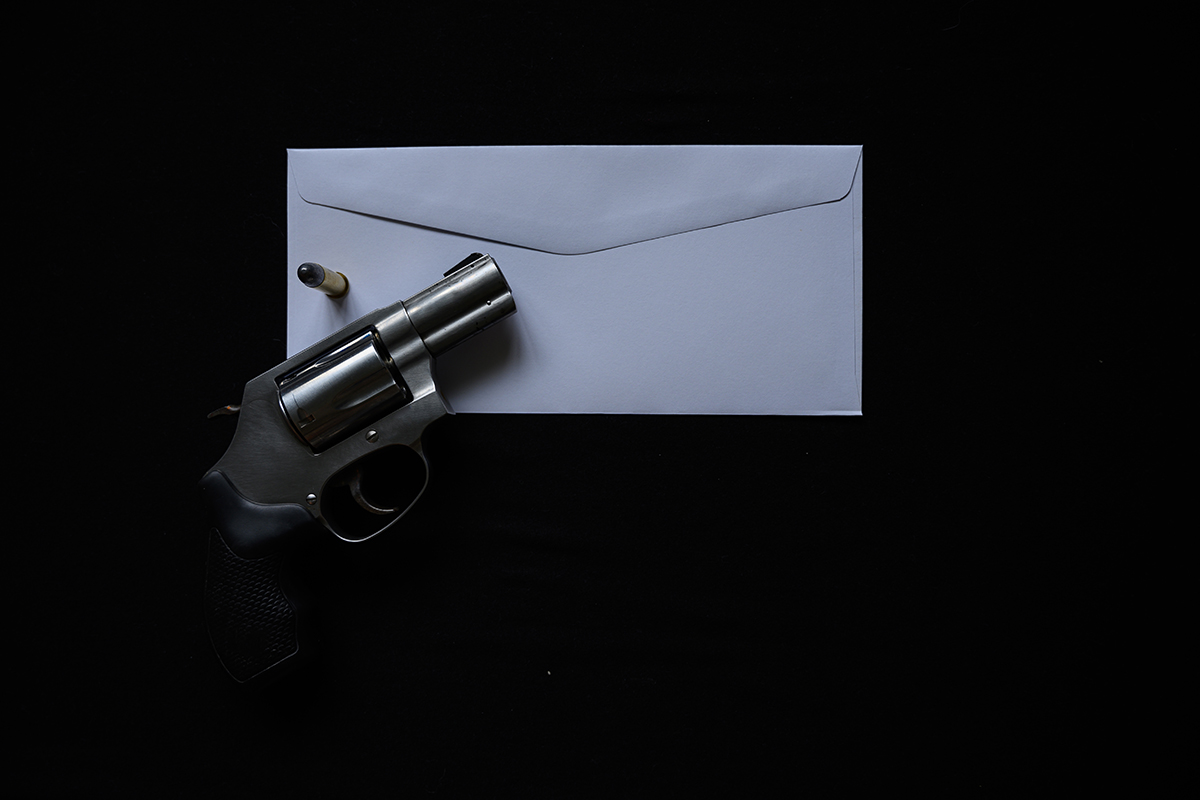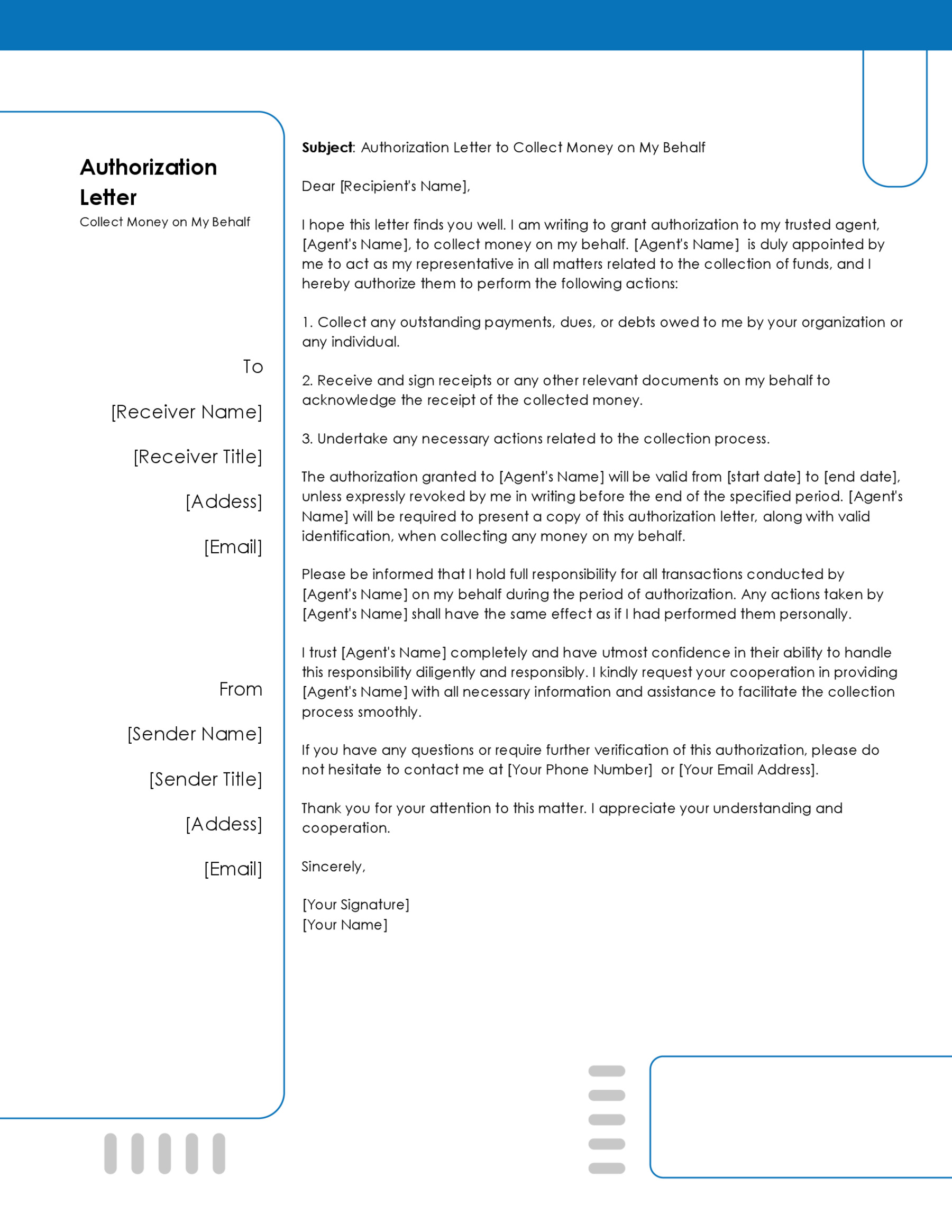This letter is used to show an employer’s gratitude for their hard work. This demonstrates that the employer is pleased with the employee’s conduct and urges them to continue in the same manner. So,
An employee recognition letter is meant to show that the employer recognizes the efforts his or her employee(s) put in at their work or recent achievements.
This demonstrates that the employer is pleased with the employee’s conduct and urges them to continue in the same manner.
Generally, there are three types of these letters which include;
- Formal letter
- Semi-formal letter
- Informal letter
For you, the employer, you can opt to use a formal or semi-formal type. Semi-formal if you are in the mid-level management, such as officers, team leaders, supervisors, etc. Formal letters are given by higher-level positions, managers, or officers. Formal recognition letters are characterized by a formal style, tone, and content to maintain a standard level of professionalism.
As an employer, you can decide to give out recognition letters on a weekly, monthly, or yearly basis. The letter can be written as an email, handwritten, or typed. It is advised that the letter be written around the time when the event or conduct being praised occurs. This recognition letter can be addressed to multiple employees, and therefore it does not necessarily have to be directed to one employee.
Additionally, it has been observed that 85% of professional employees want to receive recognition daily. 36% of women and 28% of men prefer the acknowledgment to be in writing.
Free Templates and Examples
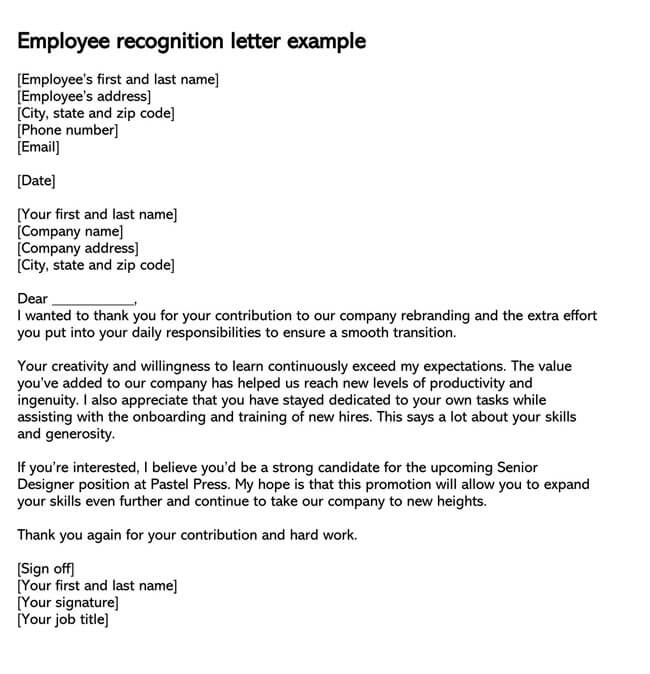
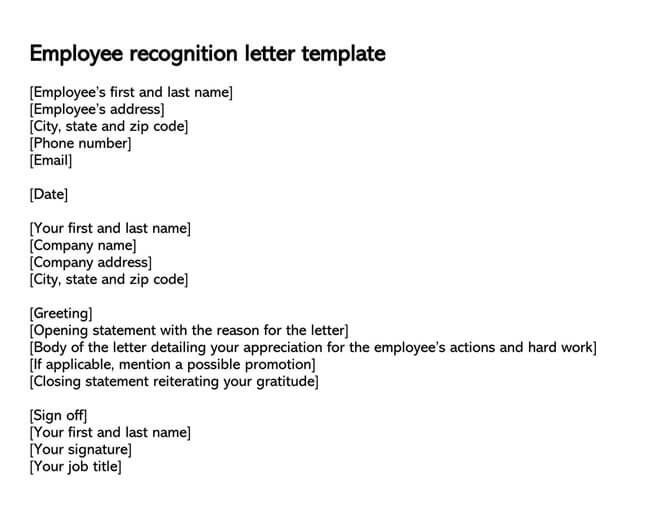
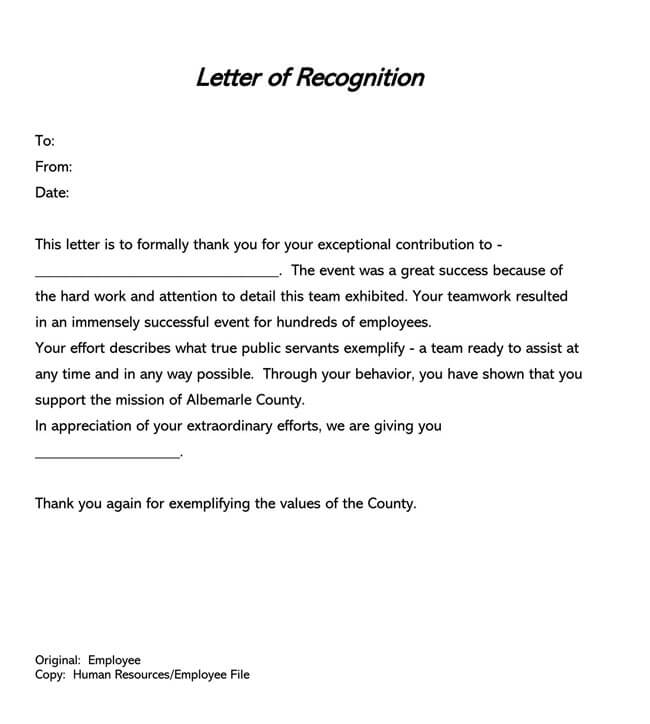
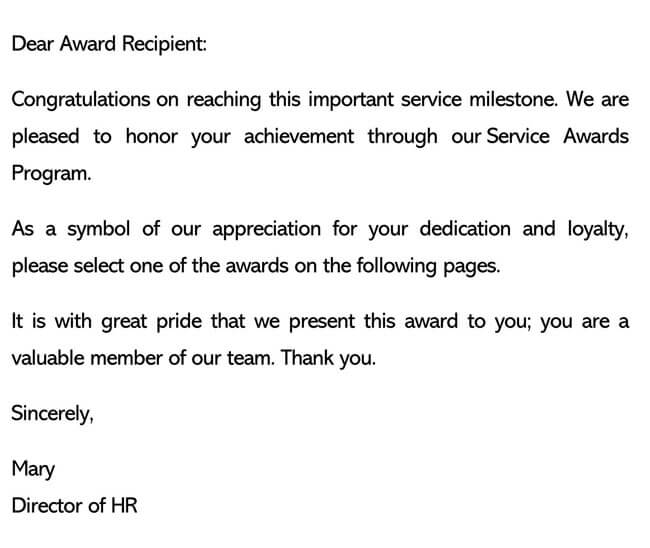
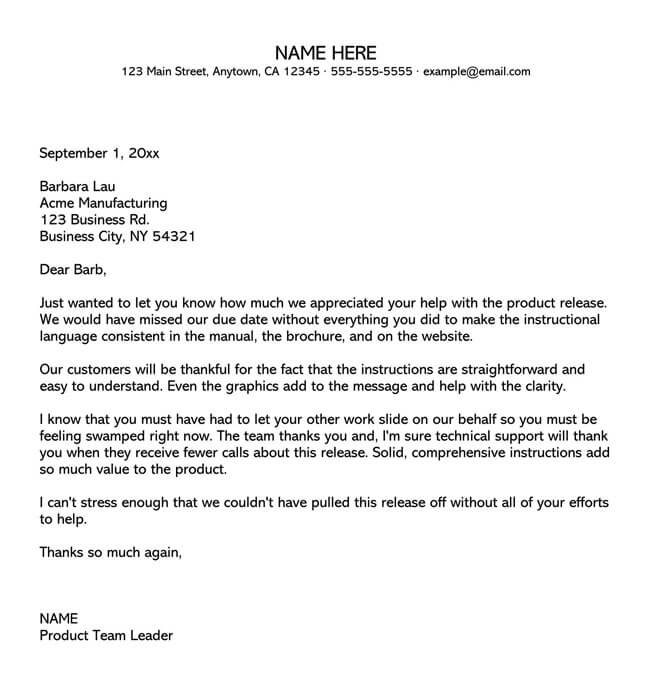

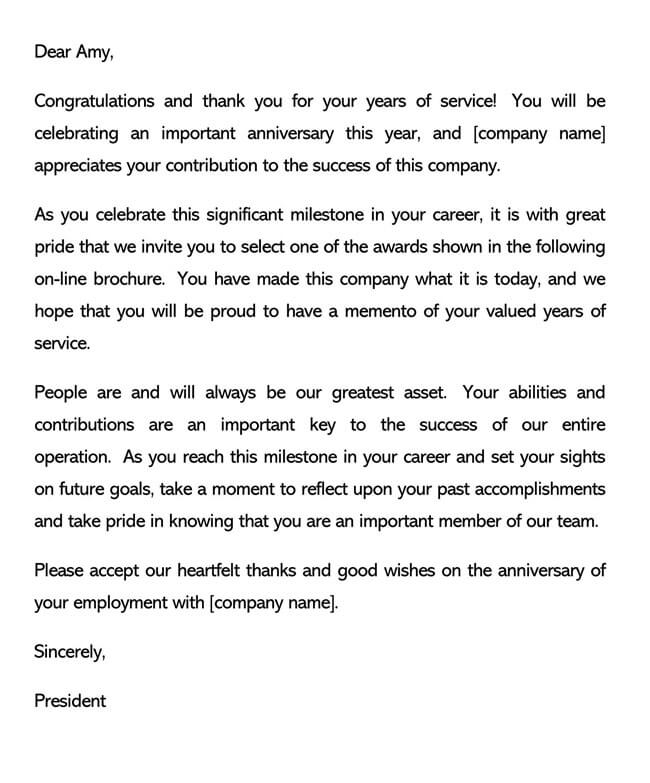
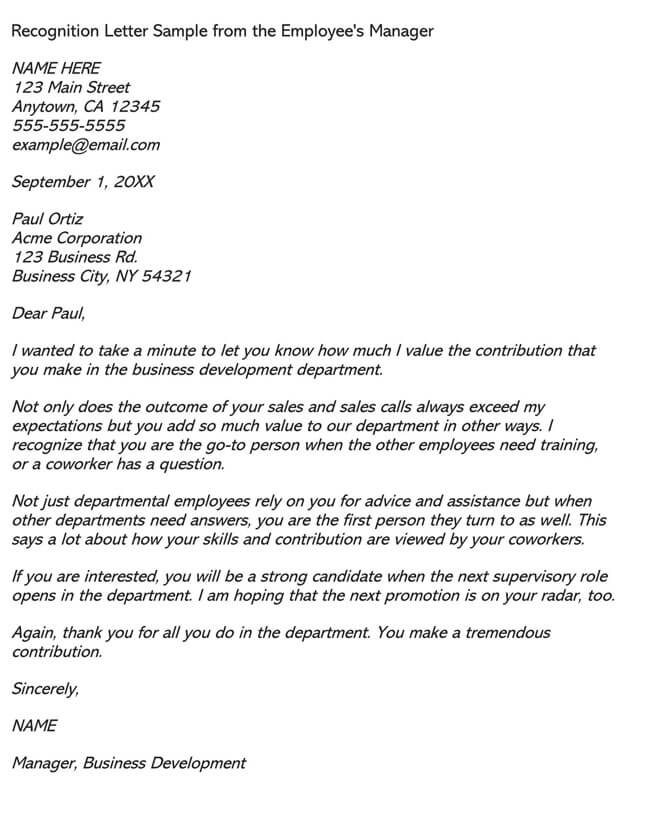
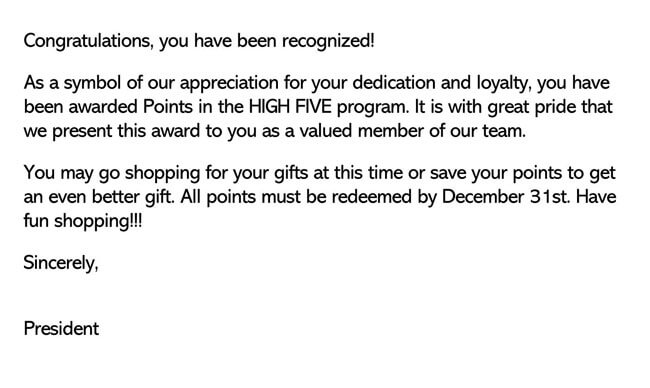
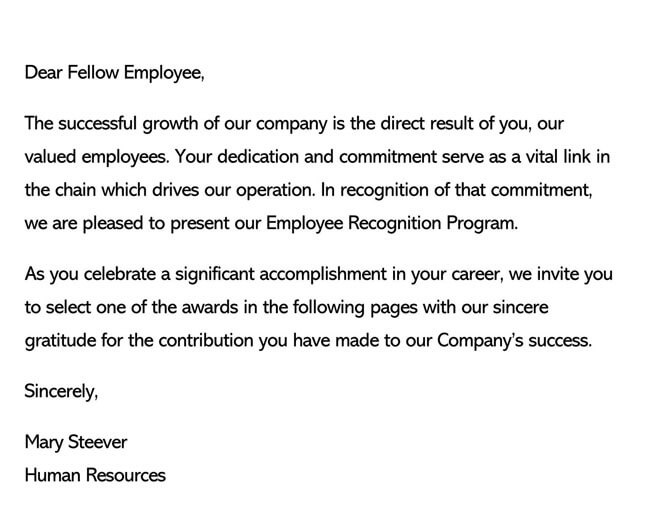
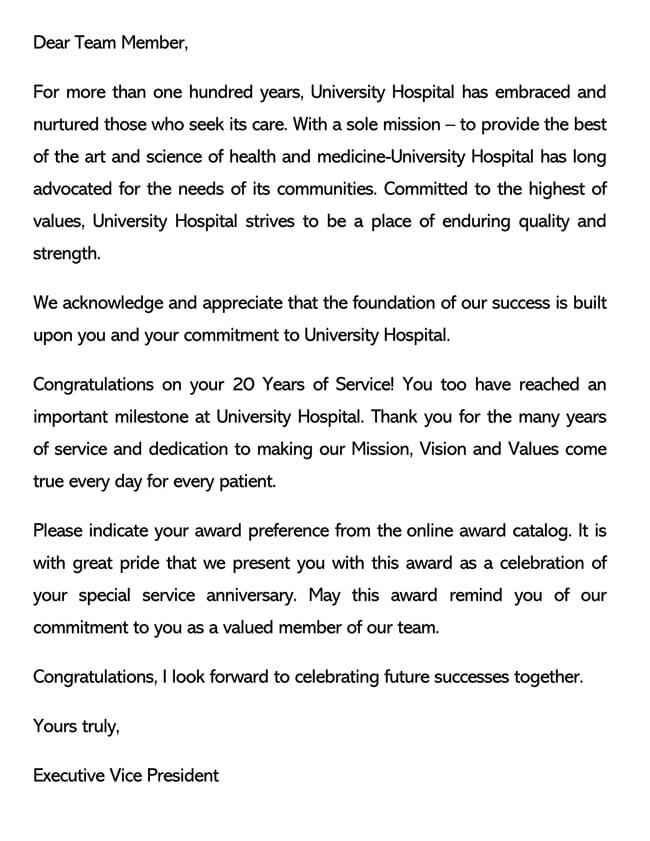
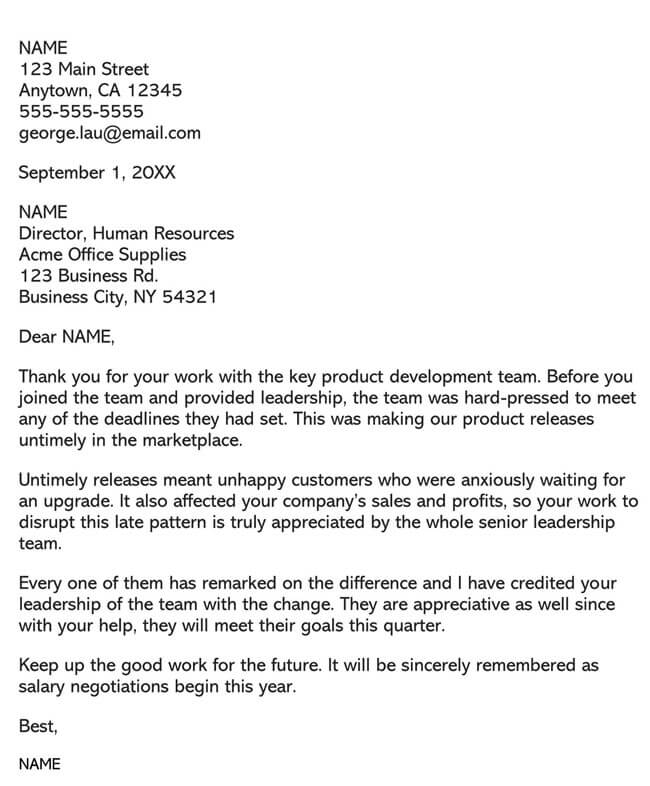
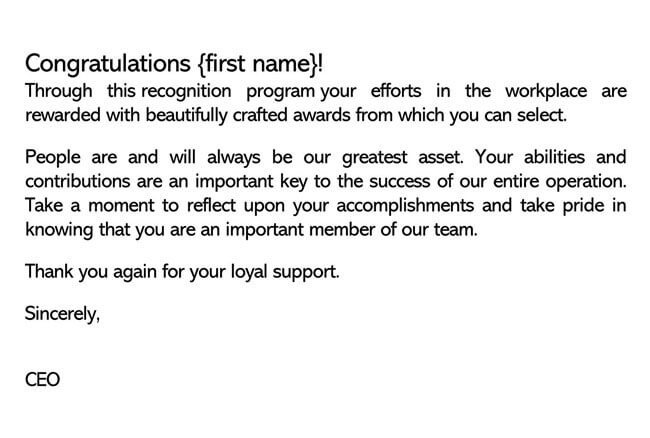
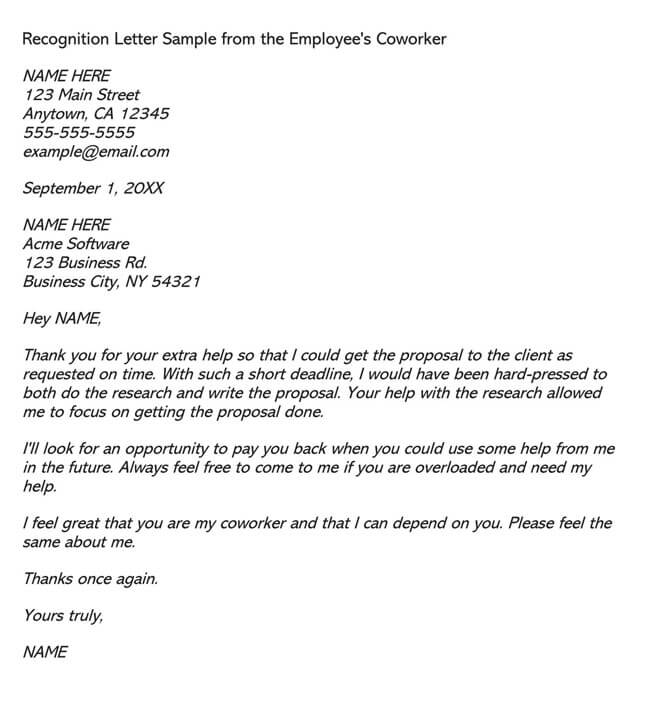
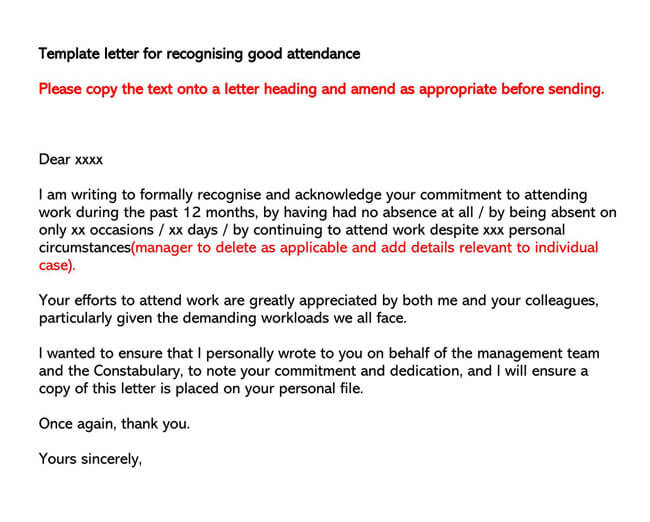
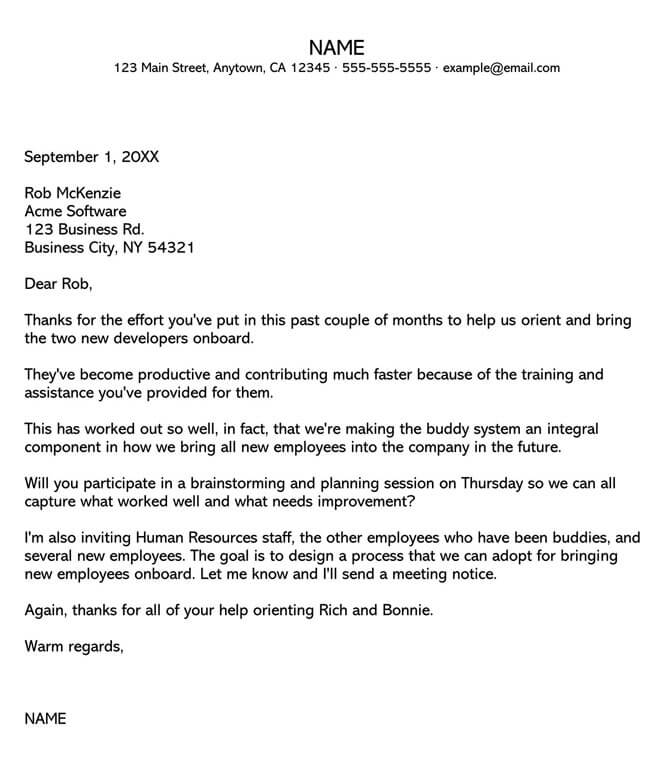
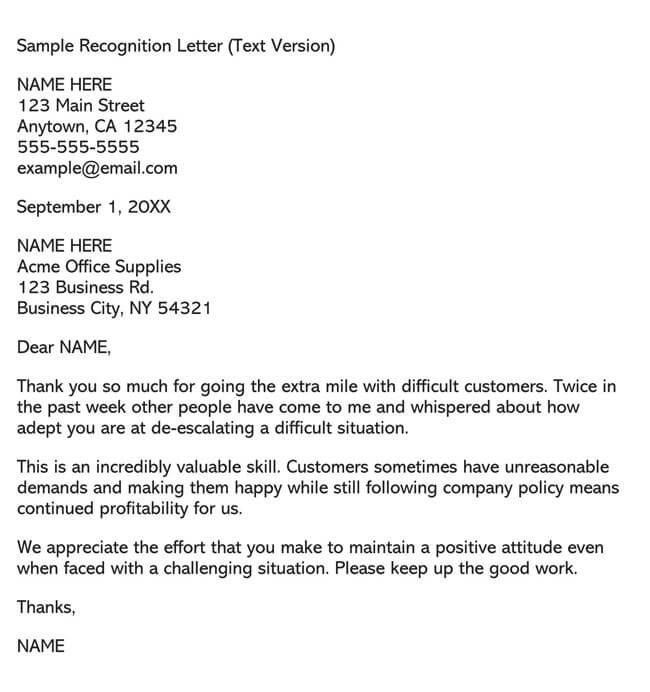
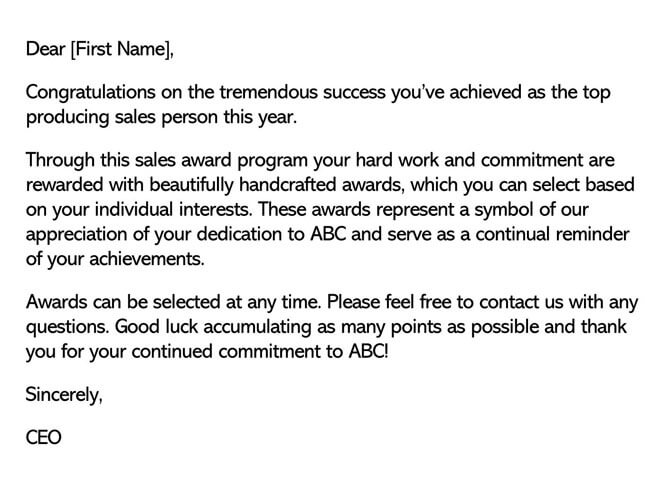
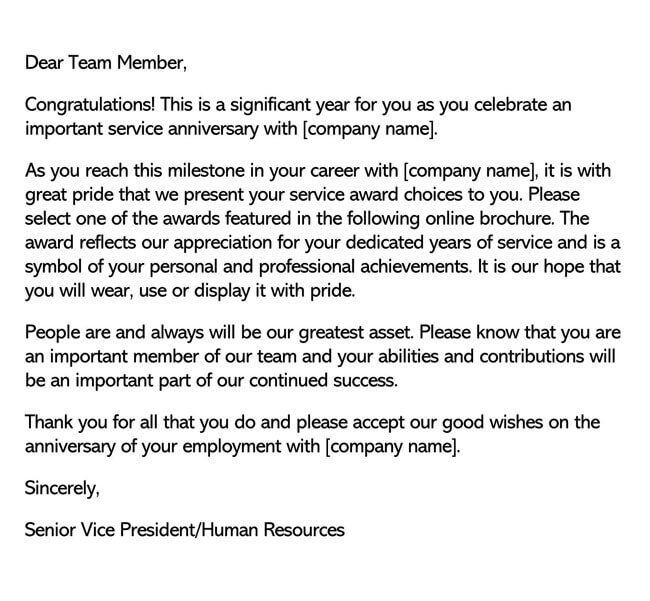
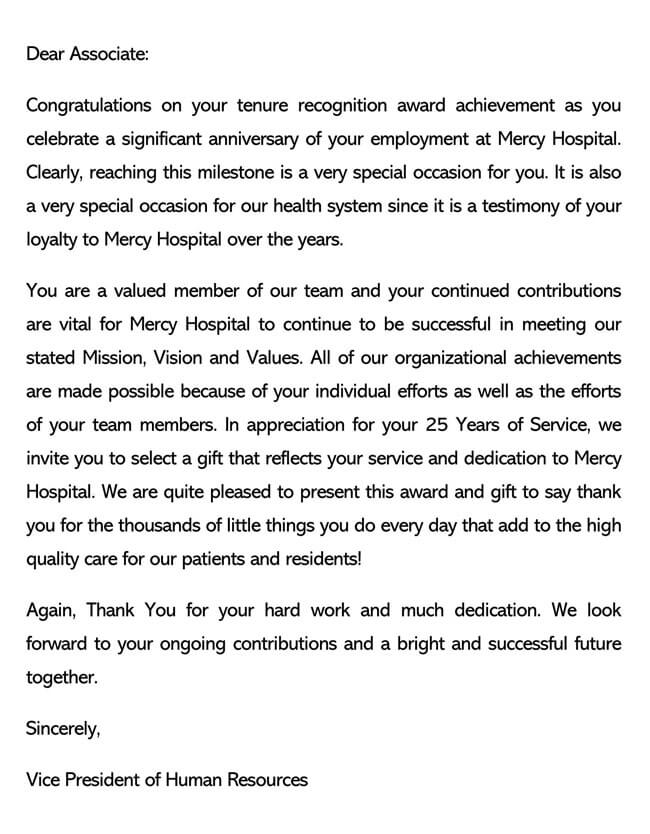
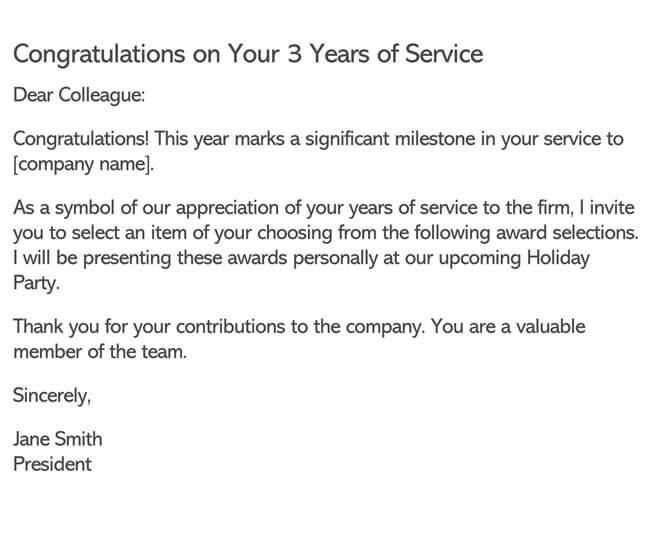
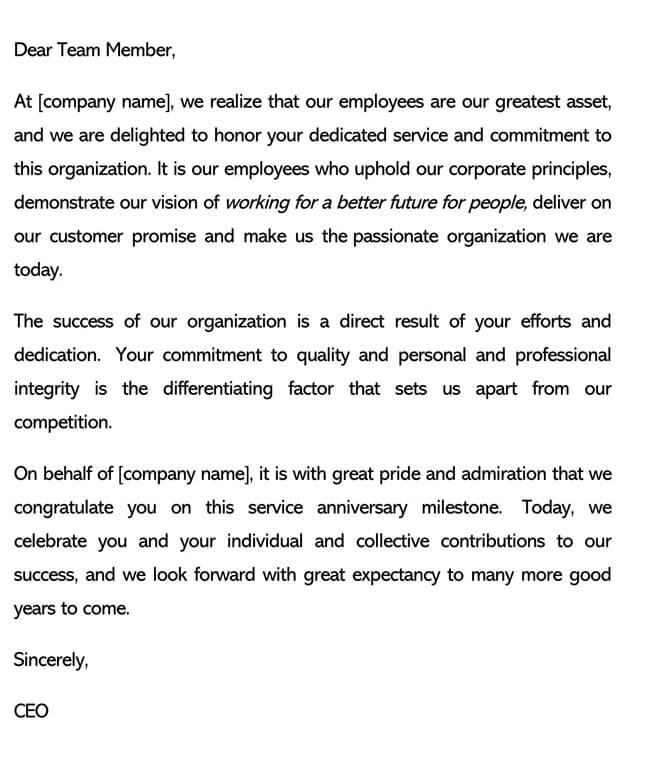
The Importance of an Employee Letter
Handing out these recognition letters has been proven to have significant benefits to an organization. For example, companies that have a recognition culture have been observed to have the following changes:
- 3 times more increased employee retention
- A 2.5 times increase in employee engagement
- 2.25 times more likely to carry out frequent recognition
- 79% more likely to give their employer’s brand a high rating.
Employee retention can be attributed to the inspiration and encouragement employees get from knowing that their efforts do not go unnoticed and that they are appreciated within their place of employment. This can be a morale booster and can lead to an increase in dedication to their work, which eventually increases productivity.
A recognition letter also helps build a strong relationship between you and your employees and can encourage them to talk to you more openly about their needs and concerns.
How to Write (Format) an Employee Recognition Letter
So, how do you write this recognition letter? What are the contents of this letter, and in what order do they appear? We shall try to answer these questions in this section.
Decide the format
The first thing you do is determine the format you wish to adopt. This is dependent on the style and culture of your company. For large corporations, emails are often used.
Mention employee’s information
The next step involves identifying the sender and recipient. This information is written in the top-left corner. For a formal recognition letter, the information to include is the name, address, phone number, and email (where applicable). Now, remember, in cases where you do not wish to sound too formal and letters are sent via email, you can just use a salutation, for example, ‘Hi Jane’ without necessarily including header information.
Start with a greeting statement
Since a recognition letter is meant to feel personal, always start with a greeting. This can be done by saying your salutation or greeting followed by the employee’s first name. For example, “Hi Martin” or “Dear Sarah” would suffice. Greetings should then be followed by a statement of the purpose of writing the letter.
EXAMPLE
Congratulations on overseeing the Nashville Water drilling project and, more so, getting it done before the scheduled date.
Write the body of the letter
After letting the recipient know the purpose of your letter, you can now proceed to demonstrate how much you appreciate them and the work they have done. You can enrich your appreciation by highlighting key points, traits, or achievements you took note of. Break down the actions that stood out most, as the aim is to encourage them to continue with this type of conduct. Leaning on their strengths is also advised. Other things you can touch on include the observed relationship between the employee and co-workers, personal encounters with the employee, and such.
pro tip
It is advisable to keep the tone formal and make it sound friendly and more open to the employee.
Conclude and sign the letter
Now that you have stated your intentions, you can include a closing statement. You can do so by reiterating your appreciation, and where a promotion or raise is due, declare it at this point in the letter. You can then sign off with the usual formal structure of “sincerely,” followed by your name and job title. A more straightforward way to do this, especially for emails, is by signing off and stating your name.
EXAMPLE
Regards
Jerry
HR manager
OR
All the best,
Angelina
Must proofread the letter
The final step is proofreading to check for errors. Reading it a few times helps determine if you have said exactly what you wanted to say. Where errors of grammar or typos appear, correct them before sending the letter. Reading it aloud can help with checking if the tone was properly observed.
Employee Recognition Letter Examples
Standard Employee Recognition Template
[Employee’s name]
[Employee’s address]
[Phone number or email]
[Date]
[Employer name]
[Company name]
[Company address]
Greeting,
[Opening statement stating the purpose of the letter] I would like to take this opportunity to show my appreciation for the time you have been with us and your continued devotion to your work.
Your efforts this past [duration, e.g., week, month, etc.] have been excellent, and we as management are happy to see such dedication from our employees. I’d like to inform you that due to the [Title] presentation you made on [date of presentation], we were able to get investors for our [Title] project.
[Mention of incentive such as promotion if applicable, for example] we plan on appointing you to spearhead the project, which would not have been possible without you.
[Closing statement] Thank you for leading from the front.
[Sign off]Sincerely/Faithfully,
[Employer’s first or last name]
[Signature]
[Job title, e.g., Manager, MD, etc.]
Sample Letters
Within this segment, you will find sample employee recognition letters that serve as practical examples for expressing gratitude and acknowledging the outstanding efforts of your employees.
Letter from a Manager
Subject: Outstanding Performance Recognition
Dear Alex Johnson,
I am writing to you today to express my sincere appreciation for your exceptional work and dedication to our sales team. Your innovative approach in reorganizing the client database has significantly contributed to a 20% increase in our department’s efficiency. It is your hard work, creativity, and commitment that set you apart.
Your efforts have not only achieved outstanding results but also inspired your colleagues to strive for excellence. As your manager, it is incredibly rewarding to witness your professional growth and achievements. Please know that your contributions are highly valued and play a crucial part in our continued success.
Thank you for your outstanding contribution to our team. We are fortunate to have you with us.
Sincerely,
Jane Doe
Sales Manager
Letter from the C-Suite
Subject: A Commendation for Excellence
Dear Michael Smith,
As a key member of Zenith Enterprises, your contributions have been invaluable in shaping the success and direction of our organization. Your leadership in the launch of our new eco-friendly product line has not only met but exceeded our expectations, demonstrating a level of excellence that is truly commendable.
Your dedication and commitment to excellence embody the values we hold dear at Zenith Enterprises. It is individuals like you who drive our company forward and help us achieve our vision and goals.
On behalf of the entire C-Suite, I extend our heartfelt thanks and congratulate you on your remarkable achievements. We are excited to see your continued growth and success within the company.
Warm regards,
Elizabeth King
Chief Executive Officer
Milestone Recognition Letter
Subject: Celebrating Your 10 Years Milestone with Horizon Tech
Dear Sarah Chen,
Congratulations on reaching this significant milestone of 10 years with Horizon Tech! Your journey through these years is a testament to your resilience, dedication, and unwavering commitment to excellence.
Throughout your tenure, you have contributed immensely to our growth and success. Your leadership in developing our award-winning software suite has left a lasting impact on our organization and its culture. This milestone is not just a measure of the time you’ve spent with us but a reflection of the valuable experiences and achievements you’ve gathered along the way.
As we celebrate this milestone, we want you to know that your efforts and loyalty have been integral to our success. We look forward to many more years of your valuable contributions and continued success.
Thank you for being an essential part of our journey.
With appreciation,
Thomas Rivera
Human Resources Director
Key takeaways
The three sample letters demonstrate effective corporate communication by fulfilling key elements of well-written professional letters:
- Each letter has a clear purpose, be it recognizing outstanding performance, celebrating a milestone, or commending high-level contributions. They provide specific examples of achievements, such as improving efficiency or launching a product line, making the recognition more impactful.
- The letters tie individual contributions to the broader goals and values of the organization. This not only validates the employee’s efforts but also reinforces the company’s mission and culture.
- The letters strike a balance between formality and warmth, suitable for their respective levels of management. This balance maintains professionalism while also being approachable and appreciative.
- Particularly in the C-Suite and milestone letters, there’s an emphasis on future contributions and continued growth, indicating trust and confidence in the employee’s potential.
In essence, these letters serve as useful examples for crafting effective professional communications that are clear, specific, aligned with company values, personalized, well-balanced in tone, and forward-looking.
Writing Tips for Employee Recognition Letter
As an employer, you want to make sure that a high level of appreciation is portrayed in the recognition letter. For this letter to serve its purpose as effectively as possible, here are some tips you can consider during your writing process:
Principles of RISE
The acronym RISE stands for Regular, Immediate, Specific, and Encouraging. These are all aspects that you should aim to represent in your recognition letter.
- Regular: Recognition letters should be handed out regularly, which could be at least once a week. This should be done as a routine practice to establish such a culture in the organization.
- Immediate: As soon as you notice particular praiseworthy conduct from your employee(s), ensure that you issue your recognition letter then. This encourages the repetition of desirable acts within the company.
- Specific: The recognition letter should be written in such a way that it feels personal. The letter’s primary focus should be on the employee being recognized and their achievements. Also, try to avoid any prevalent employee shortcomings.
- Encouraging: The recognition letter should urge fellow employees to adopt a recognition culture moving forward. Employees should be encouraged to maintain good conduct.
Apart from this, other general tips include:
- Be honest- The recognition letter should be a true reflection of your opinion about the employee in question. The employer should be sincere in terms of the information they give. Make sure praise goes to the workers who did the job.
- Be particular- You can opt to go into details of what they exactly did. This helps the employee clearly understand what they are being praised for.
- Consider their future- A recognition letter can adopt a forward-thinking approach by stating the employer’s excitement to work with the employee in the coming days and incentives such as a promotion or raise the employee can expect.
- Appraise their strengths- Highlighting the employee’s strengths can go a long way in improving their confidence. Therefore, any positive trait that was evident from their achievement can be highlighted.
- Mind your tone- Try to keep the tone formal, even though the letter should be a bit fun to read. The letter should encourage communication within the organization.
Frequently Asked Questions
A recognition letter can be used under different scenarios, such as when employers wish to thank employees for; putting in extra effort that benefited the organisation; doing an outstanding act or conduct such as helping a fellow employee; volunteering to fill in for another employee; working overtime; their service after a significant amount of time; or appreciating an employee’s active role in a company-related project, event, or activity.
Primarily, an employee recognition letter contains a description of the hard work or conduct being encouraged, specific actions the employee took that got the employer’s and general attention, a timely delivery to make sure its relevance is not compromised, and a formal but friendly tone.
Various people can send recognition letters from managers, supervisors, and leaders in an organization to co-workers.
Final Thoughts
A recognition letter for an employee can go a long way in boosting an employee’s confidence and, eventually, their performance. Organizations are recommended to make it a culture to recognize employee’s input towards the company’s sustenance. When writing a recognition letter, clearly describe your appreciation, breakdown actions, and personal encounters, and make sure to issue it as soon after the event or behavior being praised is noted. Always determine the format you want to use first, and in cases where the company has a customary format, use it. Encourage the employee to keep up. All the best.









